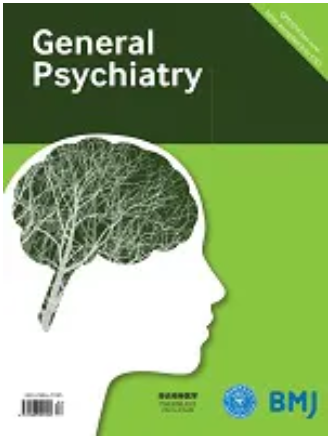血小板在精神分裂症中的新作用:预测药物反应
IF 5.3
3区 医学
Q1 PSYCHIATRY
引用次数: 0
摘要
背景血小板计数(PLTc)升高与首发精神分裂症和先兆性精神病患者的不良预后有关。然而,抗精神病药物对血小板计数的影响及其与症状改善的关系仍不清楚。目的 我们旨在研究抗精神病药物治疗后 PLTc 水平的变化,并评估在考虑其他相关变量后,PLTc 是否能预测抗精神病药物反应和代谢变化。方法 将 2985 名精神分裂症患者随机分为七组。每组接受七种抗精神病药物中的一种治疗,并在2周、4周和6周时进行评估。临床症状采用阳性和阴性综合征量表(PANSS)进行评估。此外,我们还测量了血细胞计数和代谢参数,如血脂。我们使用重复测量方差分析来研究抗精神病药物对 PLTc 变化的影响,同时使用结构方程模型来评估 PLTc 对 PANSS 变化的预测价值。结果 接受阿立哌唑(F=6.00,P=0.003)、齐拉西酮(F=7.10,P<0.001)和氟哌啶醇(F=3.59,P=0.029)治疗的患者 PLTc 明显升高。它与白细胞计数和代谢指标呈正相关。在无应答者中观察到较高的基线PLTc,尤其是在那些由PANSS阴性子量表定义的患者中。在结构方程模型中,PLTc、白细胞计数和一个潜在的代谢变量可预测 PANSS 阴性子量表得分的变化率。此外,在新陈代谢变化较小的个体中观察到较高的基线 PLTc,尽管在考虑基线新陈代谢值后这种关联不再显著。结论 血小板参数,尤其是 PLTc,会受到抗精神病药物治疗的影响,并有可能增加精神分裂症患者发生静脉血栓栓塞的风险。PLTc水平升高及相关因素可能会促进炎症,从而阻碍症状的改善。鉴于PLTc易于测量且与临床相关,因此值得精神科医生给予更多关注。试验注册号:ChiCTR-TRC-10000934。如有合理要求,可提供相关数据。本文章由计算机程序翻译,如有差异,请以英文原文为准。
New role of platelets in schizophrenia: predicting drug response
Background Elevated platelet count (PLTc) is associated with first-episode schizophrenia and adverse outcomes in individuals with precursory psychosis. However, the impact of antipsychotic medications on PLTc and its association with symptom improvement remain unclear. Aims We aimed to investigate changes in PLTc levels following antipsychotic treatment and assess whether PLTc can predict antipsychotic responses and metabolic changes after accounting for other related variables. Methods A total of 2985 patients with schizophrenia were randomised into seven groups. Each group received one of seven antipsychotic treatments and was assessed at 2, 4 and 6 weeks. Clinical symptoms were evaluated using the positive and negative syndrome scale (PANSS). Additionally, we measured blood cell counts and metabolic parameters, such as blood lipids. Repeated measures analysis of variance was used to examine the effect of antipsychotics on PLTc changes, while structural equation modelling was used to assess the predictive value of PLTc on PANSS changes. Results PLTc significantly increased in patients treated with aripiprazole (F=6.00, p=0.003), ziprasidone (F=7.10, p<0.001) and haloperidol (F=3.59, p=0.029). It exhibited a positive association with white blood cell count and metabolic indicators. Higher baseline PLTc was observed in non-responders, particularly in those defined by the PANSS-negative subscale. In the structural equation model, PLTc, white blood cell count and a latent metabolic variable predicted the rate of change in the PANSS-negative subscale scores. Moreover, higher baseline PLTc was observed in individuals with less metabolic change, although this association was no longer significant after accounting for baseline metabolic values. Conclusions Platelet parameters, specifically PLTc, are influenced by antipsychotic treatment and could potentially elevate the risk of venous thromboembolism in patients with schizophrenia. Elevated PLTc levels and associated factors may impede symptom improvement by promoting inflammation. Given PLTc’s easy measurement and clinical relevance, it warrants increased attention from psychiatrists. Trial registration number ChiCTR-TRC-10000934. Data are available on reasonable request.
求助全文
通过发布文献求助,成功后即可免费获取论文全文。
去求助
来源期刊

General Psychiatry
医学-精神病学
CiteScore
21.90
自引率
2.50%
发文量
848
期刊介绍:
General Psychiatry (GPSYCH), an open-access journal established in 1959, has been a pioneer in disseminating leading psychiatry research. Addressing a global audience of psychiatrists and mental health professionals, the journal covers diverse topics and publishes original research, systematic reviews, meta-analyses, forums on topical issues, case reports, research methods in psychiatry, and a distinctive section on 'Biostatistics in Psychiatry'. The scope includes original articles on basic research, clinical research, community-based studies, and ecological studies, encompassing a broad spectrum of psychiatric interests.
 求助内容:
求助内容: 应助结果提醒方式:
应助结果提醒方式:


